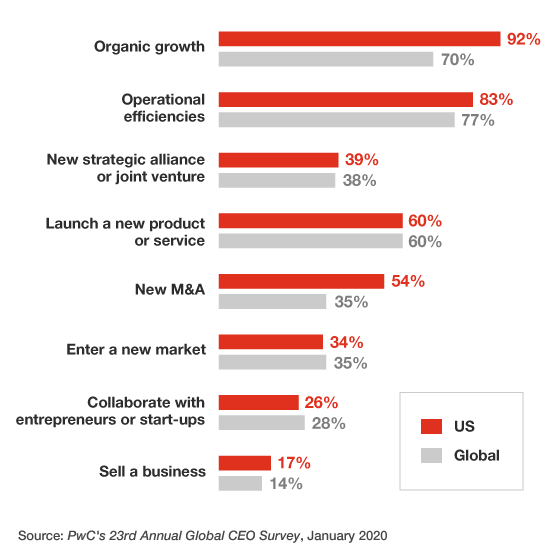{{item.title}}
{{item.text}}

{{item.text}}
US corporations are facing organizational challenges. They see huge opportunity for organic growth, but to get there they must hone market strategies, design new ways of working that maximize technology and prepare to capitalize on AI.
What, then, is the role of the leaders throughout this transformation? And how can strong leaders keep business transformation on track? We’ve distilled a set of ten guiding principles to help any leader who is starting or restarting this journey now.
Percentage of CEOs planning these activities in the next 12 months
Start with a clear, candid assessment of business conditions and the challenges facing the company. Take a market-back and customer-focused perspective, connecting transformation objectives to customer needs and marketplace dynamics. Describe the company's differentiating capabilities, and underscore the importance of channeling resources to these critical sources of competitive advantage. Conclude with an inspiring vision of the company's potential if it becomes fit for growth.
Cost transformations don't succeed unless senior management is aligned and committed to the goals. Yet the more revolutionary the change, the more likely it is that those with power and status in the old regime will resist it. Move quickly to align these key influencers behind your transformation. Give every executive a stake in overall transformation objectives, not just activities affecting his or her area. Finally, remember to link incentives—financial and otherwise—to key transformation milestones.
Along with an unflinching view of threats to the company, offer a positive, strategic vision highlighting the upside of cost transformation. Declaring a new day also conveys the message that old arguments against change no longer hold water and that you’re not interested in blaming past administrations or criticizing past decisions. Instead, paint an inspiring picture of a leaner company poised for faster growth.
Nothing succeeds like early success. Look for areas where you can rack up meaningful savings rapidly, without significant transaction costs. Highlighting quick wins builds confidence and momentum while showing you're serious about driving out costs that don't support differentiating capabilities
A credible, effective cost transformation scrutinizes every expenditure. Putting everything on the table signals the urgency of strategically aligning costs, while dissuading individual managers from lobbying for special exemptions. It also sends a message that "we're all in this together."
Big cost improvements arise from a deep analysis that questions not only how or how well a company performs various activities, but what it does in the first place. Assess your business portfolio, product line-up, customer base, operations and administrative footprint from a strategic perspective. Seek excellence only where it bolsters a capability that sets your company apart in the marketplace.
Early in a transformation, many companies prioritize cost-cutting over capability-building. This approach undermines transformation goals by demoralizing employees and limiting growth. Successful transformations build capabilities as they cut costs, using the savings to fuel step-change improvement in returns.
You need to keep doing business while you change your business. Don't ask managers and line workers to do both. Establish a program management office with responsibility for achieving transformation goals, led by a respected senior executive.
Timely, frequent and consistent communication is a hallmark of successful transformations. Skillful messaging that conveys a strong strategic vision helps to win support from key constituencies inside and outside the company.
Completing a punch-list of cost adjustments and strategic course corrections doesn't mean a transformation has succeeded. Far more important are changes in behaviors, attitudes and work habits throughout the organization. If those don't stick, neither will the transformation.
{{item.text}}

{{item.text}}

Principal, Strategy&, PwC US
Dr. Deniz Caglar is a leading practitioner in strategic cost transformation for Strategy&, PwC's strategy consulting business.











